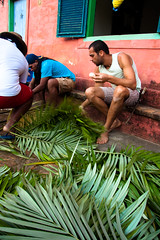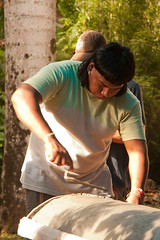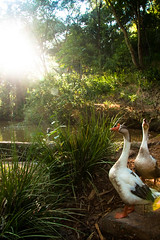We are currently making lots of different Earth Plaster blends. We had a Mexican ceramicist, Christian, residing with us for some time who started experimenting to find the perfect mix. He refined this art-form and developed a technique that was extremely strong and durable but mostly using Lime, or ‘Cal’ as a stabiliser.
We are now trying to eliminate the lime; firstly so as not to deplete our earth’s natural resources but also because another direct effect of lime when used in plaster is to reduce the ‘breathing’ effect, meaning in this sense, the ability of the plaster to absorb humidity from the atmosphere and re-release it – this controls not only the humidity of course but also the ambient temperature which in hot climates becomes greatly reduced; in cool climates warmer, or more constant.
One beautiful ingredient Marcelo has been using is ‘Taboa‘, a type of marsh reed, the seed heads which can be pulled apart to create a binder similar in appearance and texture to cottonwool. It takes a bit of time to blend it fully with the mixture but the result is well worth it.
One wall we are working on at the moment is the interior of the Adobe Dome, constructed by us in an Earth Building workshop held by adobe master Gernot Minke in late 2009. The foundation wall, holding up the adobe dome is concrete block, over which went a simple clay/sand plaster mixture. It has held up quite well over the past 1 1/2 years needing only a small amount of patching up. The finished appearance however was quite grainy so we decided it was time to give it a bit of a makeover. Now we have applied this Taboa mix and will see how it holds and how many cracks develop over the coming days and weeks. It is a deep chocolate colour in appearance and when buffed with a trowel or spoon really enhances the shine of the mica flecks which are abundant in this area.
The formula we used was as follows:-
- 1 volumetric part clay
- 1 volumetric part sand
- 1/2 volumetric part of Taboa seeds
- 1/2 volumetric part earth
- a small amount of cow dung (we used just 1 bucket for this mix, with 1 ‘volume’ being 1 wheelbarrow)
Next for the walls in the Dome we will reapply this mixture if necessary, and then above this we will use some beautiful white clay we have here to create a decorative band. We are trying out mixing Tumeric and also Urucum in with the clay to get different natural tints. See the page under ‘Plants’ on how to best extract the colour.









